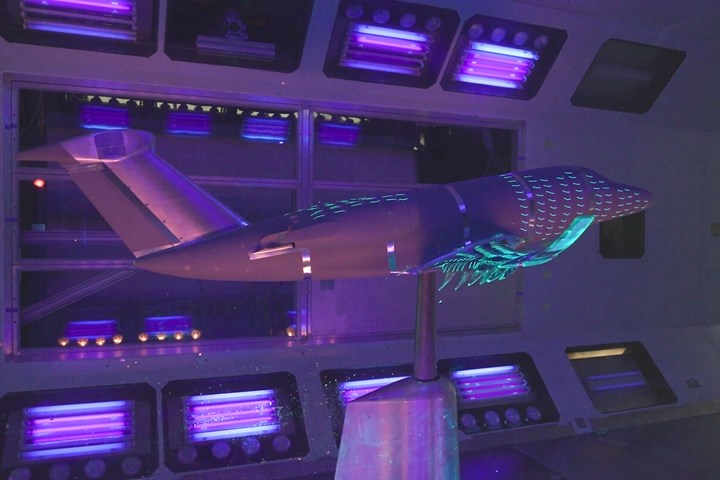Airbus eXtra Performance Wing demonstrator completes wind-tunnel tests
Technologies tested in the Filton wind tunnel — many inspired by biomimicry — will include gust sensors, pop-up spoilers and multifunctional trailing edges.

Photo Credit: Airbus
Airbus (Filton, U.K.) has completed wind-tunnel testing of its biomimetic-inspired eXtra Performance Wing demonstrator in its quest to quickly test and accelerate new technologies that will decarbonize the aviation industry.
The eXtra Performance Wing project, launched in Sept. 2021, takes inspiration from nature to improve wing aerodynamics and performance that is intended to be compatible with any future aircraft configuration and propulsion system to reduce CO2 emissions.
“The scaled demonstrator will integrate and fly breakthrough wing technologies using a remote-controlled Cessna Citation VII business jet platform in representative flight conditions,” Oliver Family, head of eXtra Performance Wing UK, explains. “The partly 3D-printed wind-tunnel model —expertly built by the aerodynamics team at Airbus’ low-speed, wind-tunnel facility in Bristol — is a scaled-down version of the Cessna jet, incorporating the lightweight, long-span design of the eXtra Performance Wing that will provide the emissions benefits we are striving for.”
Initially introduced at a smaller scale through another Airbus project, AlbatrossONE, which tested semi-aeroelastic hinged wings that, like the seabird, unlocked during flight when experiencing wind gusts or turbulence, the eXtra Performance Wing will also examine onboard technologies, like gust sensors, pop-up spoilers and multifunctional trailing edges, to enable the active control of the wing.
“Airbus’ state-of-the-art low-speed wind-tunnel is a fantastic way to validate our concepts before flight tests,” Family adds. “Our computational aerodynamic analysis capability is world class, and the wind tunnel provides another valuable way to measure the performance and capabilities of the aircraft before flight testing. The technologies we have tested in the Filton wind tunnel — many inspired by — will now be rapidly integrated for flight testing.”
The Airbus low-speed wind tunnel at Filton, near Bristol, replicates conditions similar to aircraft takeoff and landing wind speeds but is also used by external organizations testing F1 cars, ship radar systems, urban air mobility (UAM) vehicles as well as more conventional aircraft.
The eXtra Performance Wing demonstrator is hosted within , a wholly owned Airbus subsidiary, created to give future technologies a development fast-track by building demonstrators at speed and scale in order to evaluate, mature and validate potential new products and services that encompass radical technological breakthroughs.
Related Content
-
Carbon fiber/flax landing gear achieves 54% weight reduction via tailored layup optimization
Fuko’s Biogear showcases how strategic composite material distribution and natural fiber damping properties can lightweight and enhance critical aerospace structure performance.
-
University of Bristol launches composite materials to space for ISS testing
Next-gen carbon fiber materials will be tested under extreme conditions for 12-18 months to determine their viability in space for use in future space bases, interplanetary travel.
-
Schrödinger advances materials informatics for faster development of next-gen composites
Cutting time to market by multiple orders of magnitude, machine learning and physics-based approaches are combined to open new possibilities for innovations in biomaterials, fire-resistant composites, space applications, hydrogen tanks and more.






